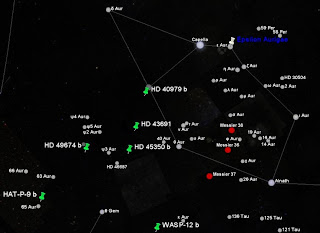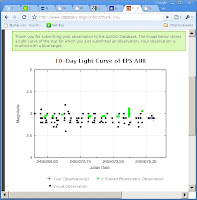 I've never really seen a star go dim. Stars may twinkle, but to actually notice a star become less brighter than previous observations over a period of weeks and months is worth an experience.
I've never really seen a star go dim. Stars may twinkle, but to actually notice a star become less brighter than previous observations over a period of weeks and months is worth an experience.Determining the apparent magnitude of stars is an observational skill worth acquiring in Astronomy. Very useful for observing Variable Stars, Cepheids, and Eclipsing Binaries.
Observing one of these eclipsing binaries called Epsilon Aurigae was the first time i ever tried seriously estimating the magnitude of stars. My experience with it was variably less than stellar (pun intended). I had to cheat by first knowing the magnitudes of other stars around it and comparing them to each other. And there is one rule that i keep repeating to myself: The brighter the star, the lower the value of its magnitude. It's well worth mentioning again because it's quite confusing. Thus it helps to remember the magnitude of a few stars near the target to set the scale. I started with Capella, the brightest star of the Auriga Constellation which has a magnitude of 0.91, while the three "kids" around it range from 3.0 to 3.88. Epsilon Aurigae (Eps Aur) is the strangest of these kids, and one that lures me into it's mystery.
The strange thing about Eps Aur is that it brightens a bit midway through it's eclipse. Some say that its eclipsing companion is a cloud that has a hole in the middle which causes the strange phenomenon. This theory is but one among many and none of them is satisfactory at this point.
Thus, the appeal of helping to solve this mystery is energized by the fact that you can join a horde of Citizen Astronomers in the effort. The folks at CitizenSky.org makes this campaign possible. And they are doing a wonderful job.

The experience i went through to submit my observations were very smooth. I admire how they accomplished the whole setup of tying in data with AAVSO to seamlessly provide me with an ID, present friendly forms to register and input my data, and then show me the graph--marked where my submission appears among the data crowd. Instant feedback!
I wanted to relate my enthusiasm with exoplanets to the mystery of Epsilon Aurigae by charting the known exoplanets within it's constellation. The result is a KMZ file for google sky, and a list at Freebase. As you can see, there is no known exoplanets nearby Eps Aur at this time. It would have been cool to compare it's magnitude with an exoplanet-host star within the same binocular field of view. I currently use my 15x50 Image-Stabilized Binoculars to compare Eta, Zeta and Epsilon's magnitudes since they all fit nicely within it's 4.5 degree FOV. I've pretty much "photographically" etched their view in my mind. And it would be exciting indeed to see the mysterious Epsilon star go dim in the coming months.
Whether exoplanets are involved or not, this is a very exciting thing to be part of. The mystery awaits!
Auriga Exoplanets:
HD 43691 b
WASP-12 b
HAT-P-9 b
HD 49674 b
HD 45350 b
HD 40979 b
Links:
CitizenSky.org
AAVSO
Epsilon Auriga

![Reblog this post [with Zemanta]](http://img.zemanta.com/reblog_e.png?x-id=468b67fc-1685-4cc5-8d2a-f705f7f9e569)